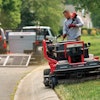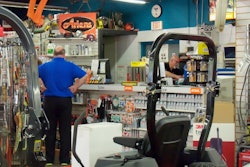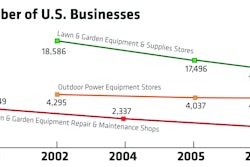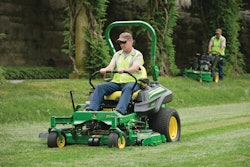Trying to open up new dealers can be a long and expensive process, especially since territory managers are often on the road servicing and convincing the current dealers to carry the proper inventory. This leaves little time to properly conduct the right analysis for identifying the ideal new dealer that you would like to have carry your product. Usually outdoor power equipment companies, or original equipment manufacturers in general, rely on basic common sense and a few data tools to help drive their decisions. But there are more advanced ways to help you, and it can save you lots of time and money too.
Challenges of opening new dealers
Let’s first examine some of the challenges of opening up a new dealer beyond just loss of time and money.
First, there is always the task of not upsetting an existing dealer who may feel slighted that you are attempting to place a “competitive” dealer within his or her own general community.
Second, you need to provide real data to the new dealer that there is growth opportunity where an existing dealer conducts business.
Sometimes, OPE companies think just plotting existing dealers and previous product sales compared to the nearest desired dealer provides enough information to guide the territory manager’s strategy. It really requires much more than that to establish a strategy. Here are a few ways to improve your method.
Get as much local marketplace information as possible
There are many data variables that should be considered at the local, county and state level. For example, population swings, housing starts, landscaper penetration per capita of acreage, household equity, local noise ordinances, competitor product sales, and more. This provides the territory manager with a solid understanding of the dynamics within the community and puts him/her on solid footing when engaging with the owner of the dealer.
Convert product registration into customers
Often OEMs think that one product registration equals one customer. And this approach can greatly mislead your analysis. At Stihl, a client of Black Ink ROI, we take 16 years worth (millions of records) of product registrations and we identify if one person bought more than one product. This helps segment two important factors. Factor one: know the difference between new versus repeat buyers. Factor two: understand the lifetime value of the customer.
For example, over the past five years I have bought four different product SKUs, across three different dealers and two different states. If one were to just look at product registration data alone, I would be four different customers of Stihl, all labeled “new.” But the true picture is that I am one repeat, multi-buyer customer with four different products. In addition, my value to Stihl is greater to date, and my future lifetime value is even greater.
Enrich the customer data
Customers move, they have home equity variances, or maybe they just changed marital status. Any number of these data points can alter their buying patterns. The more data you want to append, the more likely you need a sophisticated data management software tool to organize, hygiene, parse, and normalize the customer data to get a more precise and accurate view of your buyers. Furthermore, you may discover that two hardware dealers near each other attract different age groups, or household income, etc. So while on the surface these dealers feel like they would be sharing customers, it is often the case that they aren’t.
Discuss growth opportunities, not product category sell-in reports
Knowing the more complete view of the territory allows the salesperson to not over-index market saturation versus a perspective that presents plenty of new growth opportunity for both your EXISTING and NEW dealer. It helps the sales rep manage the possible fret of an existing dealer worried that a new dealer within a close drive distance can both exist without customer churn.
At Black Ink, we take hundreds of different third-party data variables at the zip code level and combine it with dealer information and your sales information to provide a much more precise understanding of the growth opportunities. We do it in real time, and we integrate it with your systems, automatically. The simple, easy to read reports saves you time, money and best of all, gives you a much more compelling story to each dealer why your company can help them increase their revenues.
ABOUT THE AUTHOR: Jeff Winsper offers more than 20 years of leadership experience in sales and marketing, serving companies ranging from Fortune 500 to start ups. He is the president and founder of Black Ink ROI, an advanced, customer-analytics software platform for sales, marketing and P&L leaders to improve customer acquisition, retention and upselling growth opportunities. Global customers include Stihl USA, ThermoFisher, and FlyPrivate.
Prior to launching Black Ink ROI, Jeff founded marketing agency Winsper, currently a part of Worldwide Partners, with 137 offices in 54 countries. Winsper clients experience includes IBM, SAP, Stihl USA, TimberlandPRO, UBS, Beechcraft Jets, and Carpet One Floor and Home. Previously, he was EVP at Mullen, one of the nation’s top brand agencies. And prior to that, he co-founded the agency that became Leo Burnett/Boston, New England’s largest business-to-business agency with annual billings of $260 million. Connect with him @jeffwinsper and on LinkedIn.


















![Gravely Pro Turn Mach One My23 Dsc03139 Edit 1200x800 5b2df79[1]](https://img.greenindustrypros.com/mindful/acbm/workspaces/default/uploads/2025/10/gravely-pro-turn-mach-one-my23-dsc03139-edit-1200x800-5b2df791.BucBnDoN22.jpg?ar=16%3A9&auto=format%2Ccompress&fit=crop&h=135&q=70&w=240)

